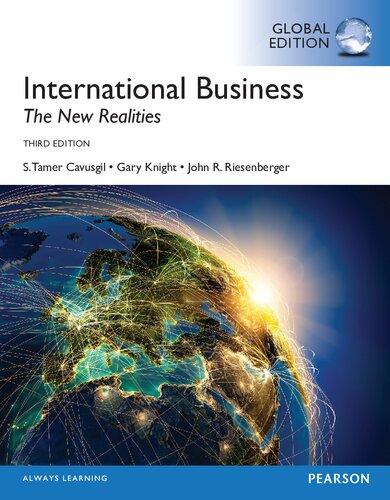Daimler AG is Germanys well-known manufacturer of premium automobiles, especially Mercedes-Benz. Chrysler Corporation was long one of
Question:
Daimler AG is Germany’s well-known manufacturer of premium automobiles, especially Mercedes-Benz. Chrysler Corporation was long one of the “Big Three” U.S. automakers, known for cars, vans, and sport utility vehicles. When these two firms merged in 1998, the deal was announced at a press conference attended by more than 300 journalists. Excitement was so great that share prices of both companies rose by 10 percent.
At the time of the merger, Daimler and Chrysler were automotive giants, and critics questioned why two successful firms would combine forces. The main reason was that global automotive production had outstripped demand for cars, global competition had intensified, and automakers were scrambling to survive. Top management at Daimler believed the solution was to expand its product offerings and extend sales to more markets worldwide. Daimler sought to acquire Chrysler, to access the latter’s complementary product line and customer base in the United States.
Daimler believed a hostile takeover would alienate customers, employees, and other constituents in Chrysler’s home market. Thus, a friendly merger was arranged and portrayed as a “merger of equals.”
The resulting marriage of two titans led to the biggest merger in automotive history. Financed by a swap of stock shares, “DaimlerChrysler”
was launched in 1998.
A Merger of Equals The \($37\) billion deal created a company with 442,000 employees, market capitalization approaching \($100\) billion, daily production of 11,000 cars, and annual revenues of nearly \($150\) billion. DaimlerChrysler became the new top player in global automaking and sent shock waves through the industry worldwide. Since each company’s strengths were seen to complement the other’s weaknesses, the merger was viewed as a near-perfect union. It was contrasted with traditional takeovers in which a large firm swallowed a smaller firm, such as BMW’s acquisition of Rover and Ford’s purchase of Jaguar.
Goals of DaimlerChrysler were to grow globally and take advantage of scale economies resulting from combining operations for R&D, sourcing, distribution, and sales. Management expected cost savings of \($3\) billion annually. The merger brought strong financial power and a range of top-selling models under one roof. The venture would combine the image of Mercedes-Benz, representing speed, luxury, and engineering excellence with that of Chrysler, representing mainstream American values and a reliable name in minivans and sport utility vehicles.
DaimlerChrysler would manufacture vehicles in thirty-four countries and sell in nearly 200. There was almost no overlap in products. Chrysler’s main market was North America (93 percent of sales), while Mercedes dominated Europe (63 percent of sales). Each firm aimed to generate synergies in international sales and other value-chain activities.
Specifically, Daimler’s goals in the merger were to:
• Broaden its market base. Until the merger, Daimler competed mainly for 20 percent of the world market, never reaching the remaining 80 percent.
• Reach more middle-class buyers, beyond those historically targeted by Mercedes.
• Build an image of a global multi-brand firm with a culture of innovation and sustainable cost structure.
• Jump ahead of competitors such as Toyota’s Lexus and Volkswagen’s Audi, through a balanced portfolio of vehicles in categories and price ranges worldwide.
• Generate cost saving by accessing Chrysler’s supply chains for parts and components.
Chrysler’s goals in the merger were to:
• Overcome the challenges of excess capacity and overproduction by consolidating operations with a strong partner.
• Become the premier auto company in the world.
• Increase sales through Daimler’s extensive distribution network, especially in Europe.
• Improve quality with help from Daimler engineers.,,,,,,,
Case Questions
1. In broad terms, what were each of Chrysler’s and Daimler’s motives for entering the merger? Evaluate the extent to which each firm accomplished these motives.
2. Explain how the DaimlerChrysler merger enhanced economies of scale and scope in the respective firms. How successful was the venture in attaining such economies?
3. What advantages did each of Chrysler and Daimler seek from their merger? What disadvantages did these firms bring to the venture? Elaborate.
4. The chapter identifies a collection of questions that managers should address before forming international collaborative ventures.
In terms of potential risks in collaboration, what issues did top management at DaimlerChrysler fail to adequately understand?
Elaborate.
5. Suggest a systematic process that Daimler could have followed to increase the likelihood of merger success. Provide examples on how Daimler might have made such a process succeed.
Step by Step Answer:

International Business
ISBN: 99710
3rd Global Edition
Authors: S. Cavusgil, Gary Knight, John Riesenberger





